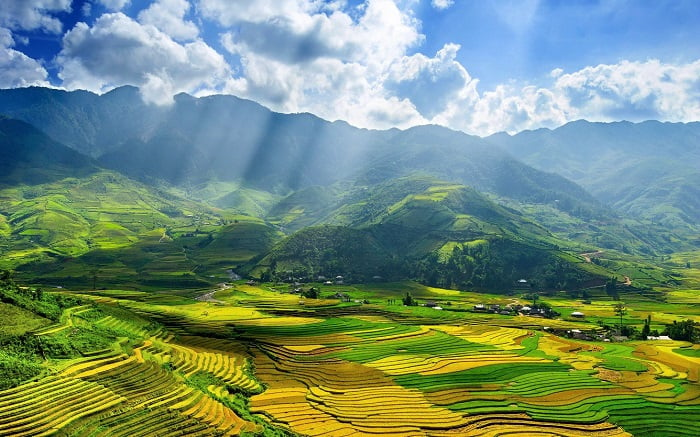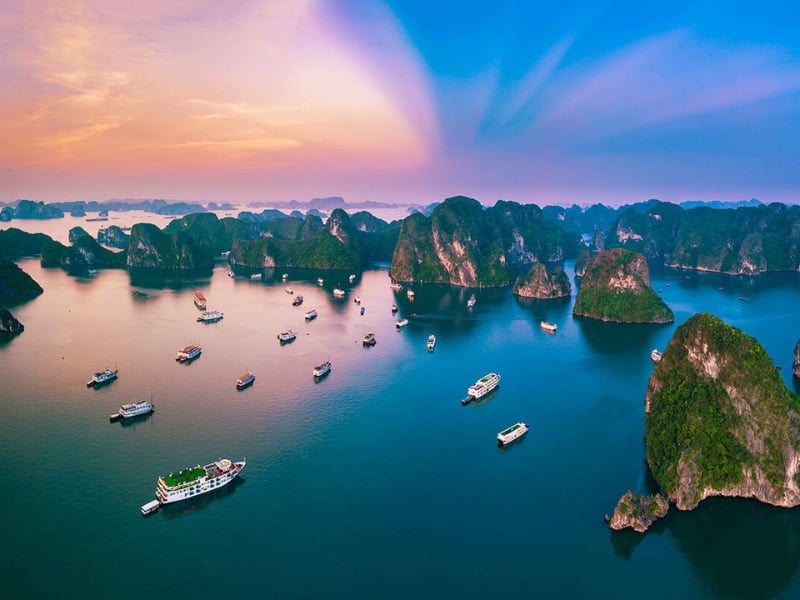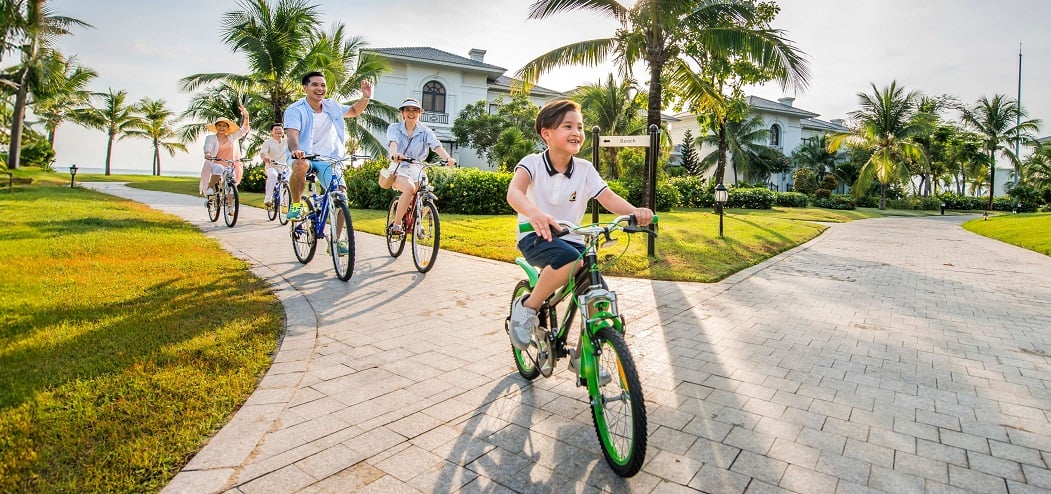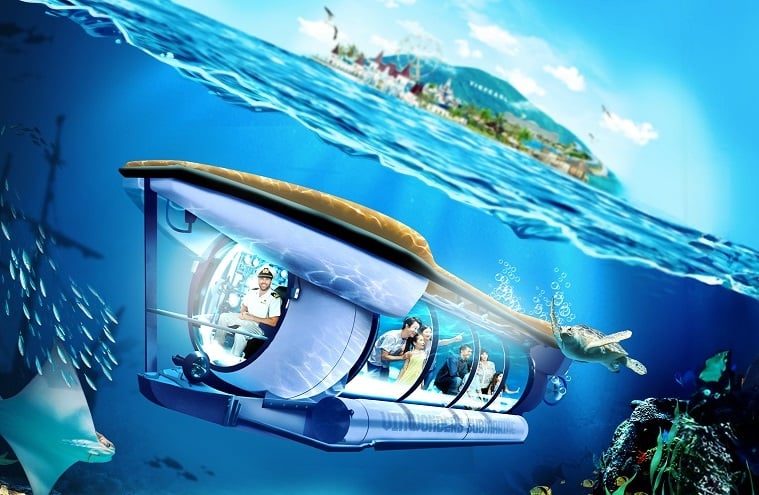
Welcoming numerous flocks of tourists each year, Vietnam is now a top tourist destination in Asia. It is a must to take a look at Vietnam's location and the basic travel information so that you will have a flawless Vietnam travel journey. Where is Vietnam located? What are the main geographical features of this country? All will be revealed below.
1. Vietnam's location in Asia and some interesting facts
1.1. Location of Vietnam
Located in the Indochina Peninsula, Southeast Asia, the Socialist Republic of Vietnam shares its border with China to the north, Laos and Cambodia to the west. To the east of this country is the South China Sea (also called the East Sea) and to the south is the Gulf of Thailand.
Regarding the area of Vietnam's location on the world map, Vietnam is the 66th largest country in the world, with 310,070 square kilometers of land and 21,140 square kilometers of water. Vietnam has a coastline of 3,444 kilometers.

1.2. Population and ethnicity
By 2022, Vietnam has a population of more than 98 million people. This country is home to 54 ethnic groups, of which the Kinh people account for the majority of the population.
1.3. Religion
Although Vietnam has no official religion, the majority of the population believes in the “Three Teachings” of Confucianism, Buddhism, and Taoism. Vietnamese people have the custom of worshiping their ancestors. The minority of the population, accounting for approximately 10%, follow Christianity, Buddhism, and other religions such as Hinduism, Muslim, etc.
1.4. Vietnamese language
Vietnamese is the national language spoken by a large majority of the country's population. About 30% of Vietnamese vocabulary is borrowed from Chinese. The writing system used to be a modified set of Chinese characters but later on, Vietnamese people developed their own script known as “chu Nom”. Since the French colonial period, a Latin alphabet with additional diacritics for tones and certain letters has been in use.
1.5. Economy
Vietnam transitioned to a market-oriented economic structure from a centrally planned one in 1986. Although Vietnam's agriculture only makes up 18% of the country's GDP, it employs 43% of the country's workforce. The service sector has grown quickly recently. Hence, tourism and hospitality have attracted huge attention from investors. The main export products of Vietnam are seafood, rice, crude oil, textile, and coffee.
1.6. Fun facts about Vietnam's location
- Vietnam is an S-shaped country. Taking a look at Vietnam on map, you can easily recognize that it is shaped like the letter “S”.
- It is a country of rivers. In total, there are 393 rivers all across Vietnam.
- Motorbike is the locals’ favorite vehicle. This vehicle can be found almost everywhere in the country.
- It is home to thousands of islands. Vietnam's coastal area has more than 5,000 islands and islets.

You may also like:
- Airlines in Vietnam: TOP 5 best domestic brands for passengers
- Central Vietnam: The TOP 10 must-visit destinations for your getaway
- Flowers of Vietnam: Explore the blooming seasons through 12 months
2. The particular geographical features of Vietnam
Next are the particular characteristics of Vietnam geographical location. It is important for first-time visitors to know about them well so that you can have the best travel plan for your upcoming trip.
2.1. Vietnam's topography
The terrain of Vietnam diversifies with mountains, plains, coasts, and continental shelves. Mountains and hills account for roughly three fourths of the total area of Vietnam. Its terrain lowers down from the northwest to the southeast.
The northeastern and northwestern areas of Vietnam have mainly mountains and hills. In the northwest is the highest mountain in Vietnam, Fansipan, also known as the Summit of Indochina. In the middle of the Northern region is the Red River Delta - one of the two largest plains in the country.

Central Vietnam’s terrain varies significantly from the west to the east. To the west lie Truong Son Mountain Range and the Central Highlands, while the east features small plains along the coastline.
Southern Vietnam perhaps has the simplest topography. Most of the region is plains. The Mekong Delta in Southern Vietnam is the country’s largest delta, covering an area of approximately 40,000 square kilometers. It is known as the main rice-cultivation area in the country.
2.2. Vietnam's coastline
Another feature of Vietnam's location is its coastline. Vietnam coastline stretches for 3,444 kilometers, facing the South China Sea to the east and the Gulf of Thailand to the south and southwest. Its waters are also home to thousands of islands and islets. Especially, Halong Bay, with more than 1,000 limestone islands and islets, was voted as one of the world’s new Seven Wonders of Nature.
What’s more, Vietnam coastline has several stunning beaches. Many Vietnamese beach destinations have been included on the list of the world’s best beaches and bays, such as Nha Trang, Phu Quoc, Lang Co, My Khe, etc.

2.3. Climate in Vietnam
Due to Vietnam's location, the country has many different weather zones. Generally, Vietnam has a tropical monsoon climate, with monsoon rains, warm temperatures (averaging 24 - 34 degrees Celsius), and high humidity all year round.
Generally, Vietnam weather can be divided into two main seasons: the rainy season (from April to September) and the dry season (from October to March). It is hard to say which is the best time to visit this country, as any season has its own charms in Vietnam.
3. The 3 major cities in Vietnam that you may not know
Another thing to know about Vietnam's location is its regions. Generally, the country is divided into 3 regions: Northern, Central, and Southern Vietnam. Hanoi, Da Nang, and Ho Chi Minh City are the three major cities in those regions respectively. They play the role of a political and economic center of each region.
3.1. Hanoi in the northern region
Hanoi is the capital city of Vietnam. Located in the Red River Delta, Hanoi is a top tourist destination in the country thanks to its long-lasting culture and beautiful natural landscapes.

With 4 distinctive seasons, Hanoi holds irresistible appeal. The weather is humid and hot in summer while it is quite cold during winter days. Each season would offer a different travel experience.
The thousand-year-old capital city of Vietnam still well preserves the tangible and intangible values of Vietnam, a nation with a long-lasting history. Here stands the Imperial Citadel of Thang Long – The social and political center of Vietnam under the Ly, Le, and Tran Dynasties in the past. Next to the citadel is the mausoleum of Ho Chi Minh – the late great leader of the country.
There are many other worth-visiting places to explore in Hanoi, such as the Old Quarter, Hoan Kiem Lake, Temple of Literature, West Lake, and Ba Vi National Park. Especially, the Old Quarter with Hanoi cuisine will definitely amaze you.
3.2. Da Nang in the central region
The city of Da Nang is famous for its dynamic vibe and exquisite nature. Featuring a tropical monsoon climate with an average annual temperature of 25 degrees Celsius, Da Nang is a tropical paradise for beachgoers.

Many Da Nang beaches, such as Non Nuoc and My Khe, are renowned for their awe-inspiring seascapes, transparent water, and soft sandbank. These places are ideal for a leisurely summer vacation. In addition, the foods and drinks found in Da Nang are excellent with very reasonable prices. In addition, the traffic in Da Nang is light and safe. Many excellent accommodations, including luxurious resorts with international-standard villas, are available.
3.3. Ho Chi Minh City in the Ssuthern region
Vietnam's biggest metropolis, Ho Chi Minh City, is the heart of Southern Vietnam. Also called Saigon, the city used to be the economic and entertainment center of Indochina. It was named after the great leader of Vietnam, President Ho Chi Minh, after the Second Indochina War in the 20th century.

Ho Chi Minh City is a top Vietnam destination for cultural and historical tours. Here, the architecture and lifestyle are influenced by American and Chinese cultures with numerous modern touches, yet not at the expense of traditional elements.
The Independence Palace, which marks the reunification of the North and the South of Vietnam in 1975 and the end of the War, is a must-visit destination. Other relics such as Cu Chi Tunnels, Dragon Wharf, and Notre-Dame Cathedral are also amazing places for tourists to explore.
You may also like:
- Mid Autumn Festival In Vietnam: Enjoy the jubilant ambiance on a full moon
- Nightlife in Vietnam: 10+ MOST vibrant places for gathering and more
- Female names in Vietnam: 100+ MOST popular names from A to X
4. Things to know for a perfect trip to Vietnam for backpackers
To have a perfect travel plan, aside from Vietnam's location, there are more things that you need to know about. Below are some other essential information about the country.
4.1. Public holidays of Vietnam and tourist seasons
Vietnam has a particularly rich culture and history. As a result, there are lots of festivals and cultural events taking place all year round all across the country.
4.1.1. Public holidays in Vietnam
Regarding public holidays in Vietnam, there are 8 occasions in a year when the locals have days off from work.
- New Year's Day: January 1st, also an international public holiday
- Tet Holiday (Vietnamese Lunar New Year): the first days of the lunar year
- Hung King Commemoration Day: the 10th day of the 3rd month in the lunar calendar
- National Reunification Day: April 30th
- Labor Day: May 1st
- National Day: September 2nd

Beside the above-mentioned national Vietnamese holiday, there are many other significant festivals and events during the year. Together with Tet Holiday, Vu Lan Festival (on the full moon day of the 7th lunar month) and Mid-Autumn Festival (on the full moon of the 8th lunar month) are the 3 biggest cultural events that take place all over the country.
Each province also has its own cultural and historical occasions to celebrate, making Vietnam an appealing destination for culture lovers. Some notable events you should not miss out on during your trip are the Perfume Pagoda Festival in Hanoi, Hue Festival in Hue, Lim Festival in Bac Ninh, and Lantern Festival in Hoi An, to name a few.
4.1.2. Tourist seasons in Vietnam
There is no specific ideal time to travel to Vietnam. Due to the diversity in Vietnam's location and weather, the country holds different appeal in each region and season. As mentioned above, the weather in Vietnam is divided mainly into 2 seasons: the dry and the rainy season. Needless to say, the dry season would be the better time to visit the country. Travelers are expected to experience sunny skies and jaw-dropping landscapes.
- Northern Vietnam (Hanoi, Halong Bay, Sapa, Ha Giang, Ninh Binh, etc.) has the most rainfall between June and September
- Central Vietnam (Hue, Da Nang, Hoi An) has heavy rains during winter months (October and November)
- Southern Vietnam (Saigon, Can Tho, Phu Quoc) also has the most rainfall from June to September
4.2. Vietnamese money and currency exchange
The official currency in Vietnam is the Vietnamese Dong (abbreviated VND, dong, or just “d”). The common banknotes in use are the 1,000 VND; 2,000 VND; 5,000 VND; 10,000 VND; 20,000 VND; 50,000 VND, 100,000VND, 200,000 VND, and 500,000 VND.

The US Dollar (USD) is widely accepted in big hotels and restaurants. However, when you travel to less-known areas in Vietnam's location or want to buy food and stuff from local vendors and stalls, it is better to use the dong. Many local businesses, especially street vendors, only accept the dong. You can exchange money for Vietnamese Dong at airports, banks, and hotels throughout the country. Credit cards are accepted in the hotels of major cities only. Visitors are recommended to carry cash only in small amounts.
4.3. The top Vietnam destinations to visit once
Vietnam's location has blessed this country with quintessential natural scenery. Additionally, the 4,000 years of history have brought about an extraordinarily rich culture to this land. There are several beautiful tourist attractions from the North to the South, which are definitely worth your visit.
Which part of Vietnam is best to visit? Following are the best locations in Vietnam that travelers should not miss out on during their trip.
4.3.1. Halong Bay

This is a must-see place in Northern Vietnam. This UNESCO World Natural Heritage covers an area of 1,500 square kilometers with thousands of limestone islets. Ha Long Bay possesses a jaw-dropping seascape with emerald sea water and a cluster of limestone karst.
Voted as one of the new Seven Wonders of Nature, Ha Long Bay is undoubtedly a must-see for a Northern Vietnam trip. You can take an overnight cruise to watch the breathtaking seascape or participate in fascinating activities, such as exploring karst caves, kayaking, and enjoying a sunset party on the cruise.
4.3.2. Sapa
Located in a mountainous area, Sapa is the best destination for adventurous travelers in Northern Vietnam. The exquisite natural settings, with dense forests and colorful rice terraces, are an undeniable allure to visitors.
Many ethnic minorities, including the H'Mong, Tay, Dao, and Thai, reside in Sapa. Paying a visit to their villages, travelers can not only see the breathtaking scenery here but also get exposure to the local people’s life and culture.

You may also like:
- Vietnam money: The BEST guide for your cost-conscious trip
- Asia travel: A worthwhile journey to explore nature and culture
- Vietnamese Reunification Day: Date, History & Celebration Activities
4.3.3. Ha Giang
Ha Giang is a fantastic Vietnam's location for brave adventurers thanks to its rugged mountains, marvelous terraced fields, deep valleys, and lush forests. The province is also home to many ethnic minorities, who still well-preserve their authentic cultural identities. Since it has not been affected by mass tourism, Ha Giang still holds an untouched beauty that could steal the heart of any traveler.
4.3.4. Ninh Binh
Ninh Binh is a not-to-be-missed destination on the Vietnam map for tourists. This province offers breathtaking limestone mountains with marvelous karst caves. It is also home to many significant historical and cultural sites, such as Hoa Lu Citadel, Bai Dinh Pagoda, etc.
4.3.5. Hai Phong
Hai Phong is a dynamic city with a long-lasting history and rich culture. It is home to Cat Ba Island and Lan Ha Bay, where you will be left in awe by their marvelous seascapes. Hai Phong food is also a huge appeal to tourists.
4.3.6. Quang Binh

Quang Binh has a complex of alluring karst caves of significant geological values. Some notable caves are Phong Nha – Ke Bang, Thien Duong, and Son Doong – the largest cave in the world. Nhat Le Beach is another favorite tourist attraction for a summer escape in this province.
4.3.7. Hue
This city is a must-see destination for culture lovers. Here situates the Imperial Citadel of Hue – the biggest citadel of Vietnam, which is known as a masterpiece of Eastern architecture. In addition to historical sites, Hue is also famous for its landscapes with the poetic Huong River and Lang Co Beach.

4.3.8. Hoi An
Hoi An Ancient Town used to be an important trading port in Asia in the 15th and 16th centuries. Here, visitors can see the influences of Chinese, Japanese and French cultures via the architecture, cuisine, and customs.
In addition to ancient houses and buildings, Hoi An also attracts visitors with stunning nature. The beauty of the poetic Hoai River, the wild nipa palm forest, and the pristine An Bang Beach can capture the hearts of tourists at first sight.
4.3.9. Nha Trang
Nha Trang has many beaches that are widely regarded as some of the most beautiful beaches in the world. Possessing soft sand and turquoise sea water, Nha Trang beaches have become famous destinations for beach getaways.
The city also has rich culture and history. There are Po Nagar Cham Towers that display the superb architecture and culture of the ancient Cham people. Long Son Pagoda and Christ the King Cathedral, which show the influence of Taoism and Catholics in Nha Trang, are also worth a visit.

4.3.10. Mekong Delta
Vietnam's location in the Mekong Delta has made this area the breadbasket of the country. It will be interesting to sit on a boat that goes along the Mekong River, come across lush rice paddies, and explore the local life.
4.3.11. Phu Quoc
Phu Quoc Island has gained a huge reputation for its dense tropical forests, beautiful white sand beaches, and colorful coral reefs. The untouched nature of this island has made it the best location to stay in Vietnam for a leisure trip.
Proud to be a beach paradise, Phu Quoc has more than nature to offer. It is home to several world-class hotels, resorts, and entertainment centers, such as Vinpearl Phu Quoc, VinWonders Phu Quoc, etc. Hence, this is an ideal place for travelers of all ages and preferences.

You may also like:
- Best places to visit in Vietnam: TOP 15+ exotic spots not to be skipped
- Vietnam capital: Things to know before your departure
- Rainy season in Vietnam: The BEST guide for your future backpacking tour
4.4. The best location to stay in Vietnam
The tourism industry in Vietnam has developed rapidly in recent years. Hence, there are a wide variety of accommodation options. In different Vietnamese locations, there are different types of accommodation. For example, in the mountainous Ha Giang where most tourists are trekkers and adventurous travelers, small hotels and homestays are the preferable options. Meanwhile, in big cities and famous destinations, there are many first-class hotels and resorts that offer tourists high-end facilities and services.
Among the long list of hospitality brands all across Vietnam, Vinpearl is one of the leading names. It is a chain of luxury hotels and resorts in most famous cities and beach destinations in Vietnam.

Take a look at the top-class hotels and resorts of Vinpearl here:
>>> Book rooms in Vinpearl Phu Quoc, Vinpearl Nha Trang, Vinpearl Resort & Golf Nam Hoi An for a pleasant stay in Vietnam
Vietnam keeps surprising travel enthusiasts with its breathtaking nature and rich culture. Hopefully, this article about Vietnam's location will help you better plan your upcoming trip to this S-shaped country.
























